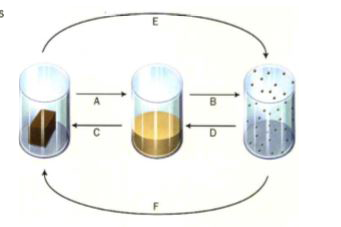Phase transitions are ubiquitous in nature. We are all familiar with the different phase of water (vapour, liquid and ice) and with the change from one to another, the change of phase are called phase transitions. There are six ways a substance can change between these three phase, melting, freezing, evaporating, condensing sublimation and decomposition.
At pressure vaporisation of mole of water from liquid to vapour .
at
Calculate change in internal energy when
Water liquid at to ?
The correct Answer is:A
Topper's Solved these Questions
- BOOK - RESONANCECHAPTER - THERMODYNAMICSEXERCISE - Exercise-3 Part-1: JEE (ADVANCED)11videos
THERMODYNAMICS
- BOOK - RESONANCECHAPTER - THERMODYNAMICSEXERCISE - Main5videos
THERMODYNAMICS
- BOOK - RESONANCECHAPTER - THERMODYNAMICSEXERCISE - Exercise 2- III : One or more than one options correct type14videos
THERMODYNAMICS
- BOOK - RESONANCECHAPTER - TEST SERIESEXERCISE - CHEMISTRY50videos
TEST SERIES
Similar Questions
Phase transitions are ubiquitous in nature. We are all familiar with the different phase of water (vapour, liquid and ice) and with the change from one to another, the change of phase are called phase transitions. There are six ways a substance can change between these three phase, melting, freezing, evaporating, condensing sublimation and decomposition.
At 1atm pressure vaporisation of 1 mole of water from liquid (75∘C) to vapour (120∘C).
Cv(H2O,l)=75Jmole−1K−1,Cp(H2O,g)=33.3Jmole−1K_1
ΔHvap at 100∘C=40.7KJ/mole
Calculate change in internal energy when
Water liquid at 100∘C to vapour at 100∘C ?View SolutionPhase transitions are ubiquitous in nature. We are all familiar with the different phase of water (vapour, liquid and ice) and with the change from one to another, the change of phase are called phase transitions. There are six ways a substance can change between these three phase, melting, freezing, evaporating, condensing sublimation and decomposition.
At 1atm pressure vaporisation of 1 mole of water from liquid (75∘C) to vapour (120∘C).
Cv(H2O,l)=75Jmole−1K−1,Cp(H2O,g)=33.3Jmole−1K_1
ΔHvap at 100∘C=40.7KJ/mole
Calculate change in internal energy when
Water vapour at 100∘C to 120∘C ?View Solution
Knowledge Check
- Question 1 - Select One
Phase transitions are ubiquitous in nature. We are all familiar with the different phase of water (vapour, liquid and ice) and with the change from one to another, the change of phase are called phase transitions. There are six ways a substance can change between these three phase, melting, freezing, evaporating, condensing sublimation and decomposition.
At 1atm pressure vaporisation of 1 mole of water from liquid (75∘C) to vapour (120∘C).
Cv(H2O,l)=75Jmole−1K−1,Cp(H2O,g)=33.3Jmole−1K_1
ΔHvap at 100∘C=40.7KJ/mole
Calculate change in internal energy when
Water liquid at 100∘C to vapour at 100∘C ?A40700JB37598.878JC43801.1JD31012.J - Question 2 - Select One
Phase transitions are ubiquitous in nature. We are all familiar with the different phase of water (vapour, liquid and ice) and with the change from one to another, the change of phase are called phase transitions. There are six ways a substance can change between these three phase, melting, freezing, evaporating, condensing sublimation and decomposition.
At 1atm pressure vaporisation of 1 mole of water from liquid (75∘C) to vapour (120∘C).
Cv(H2O,l)=75Jmole−1K−1,Cp(H2O,g)=33.3Jmole−1K_1
ΔHvap at 100∘C=40.7KJ/mole
Calculate change in internal energy when
Water vapour at 100∘C to 120∘C ?A666JB2998JC499.72JD166.28J - Question 3 - Select One
The phase transition from gas to solid is called:
AdepositionBdesublimationCboth a and bDsublimation
Differentiate between
a change of state and a phase change
View SolutionHeat supplied to a solid changes it into liquid. What is this change in phase called ?
View SolutionWrite phase changes in the diagram.
 View Solution
View SolutionCalorimetry (phase change)
View SolutionThe unusual properties of water in the condensed phase (liquid and solid states) are due to the
View Solution

